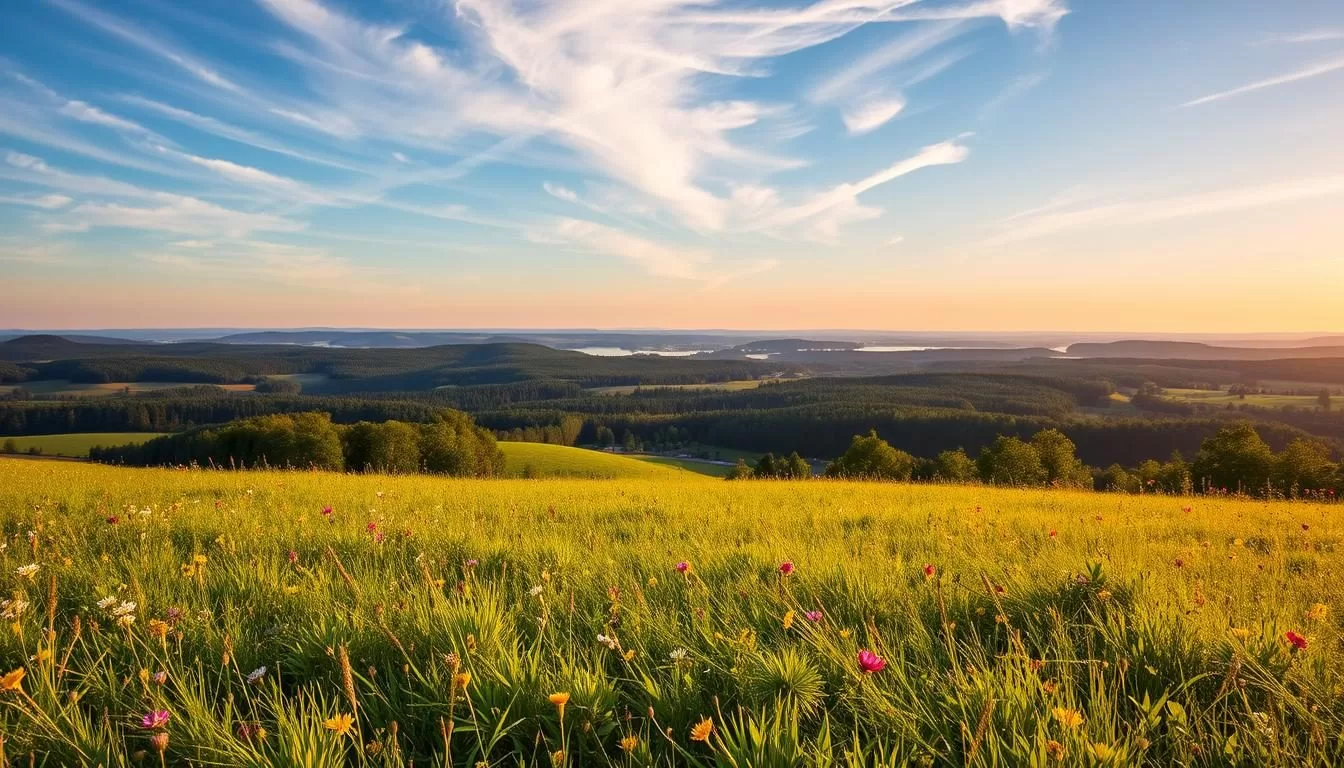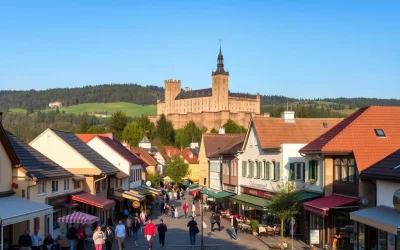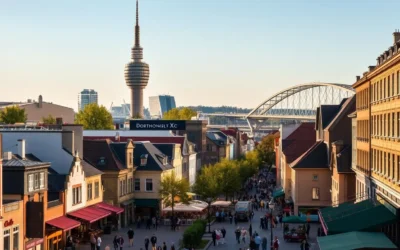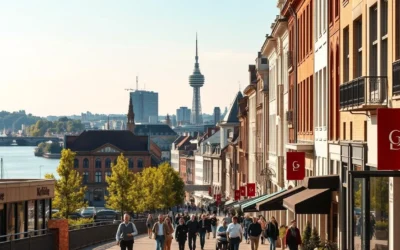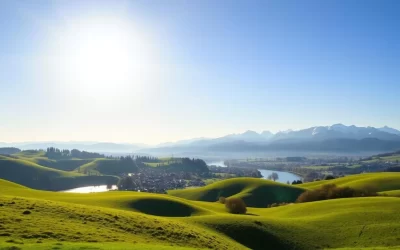✓ Accommodations ✓ Flights ✓ Rental Cars
Planning a trip to this stunning region? Timing is everything. Whether you’re drawn to blooming cherry blossoms in spring, sunny summer days by the lake, or the vibrant colors of fall, each season offers something unique. Knowing the best time to visit can make your experience even more memorable.
This guide will help you navigate the climate and weather patterns throughout the year. You’ll learn how to avoid peak crowd periods while enjoying the region’s natural beauty and cultural events. From mild temperatures to festive celebrations, we’ve got you covered.
Ready to explore? Let’s dive into the details to help you plan the perfect visit to this enchanting place.
Overview of Seasonal Weather Trends in Mecklenburg-Vorpommern
The region’s climate varies significantly throughout the year. Understanding these changes can help you decide the best time to visit. From warm summers to chilly winters, each season brings its own charm and challenges.
Understanding Average Temperatures and Precipitation
The warmest months are from June to September, with average highs around 66°F. This is the perfect period for outdoor activities like hiking or swimming. On the other hand, the cold season sees temperatures drop below 44°F, making it ideal for cozy indoor experiences.
Rainfall is fairly consistent, averaging 1.9 inches on rainy days. Snow is rare but possible during the winter months. Knowing these patterns can help you pack appropriately and plan your itinerary.
Identifying Clear and Cloudy Periods
The region enjoys a clear sky for about 6.5 months of the year. This is when you’ll find the most sunshine, especially during the summer. Cloud cover increases in the colder months, but even then, there are plenty of bright days to enjoy.
Here’s a quick breakdown of the average weather conditions:
| Season | Average Temperature | Precipitation | Sky Clarity |
|---|---|---|---|
| Spring | 50°F – 60°F | 1.8 inches | Partly Cloudy |
| Summer | 66°F – 75°F | 1.9 inches | Mostly Clear |
| Fall | 55°F – 65°F | 1.7 inches | Partly Cloudy |
| Winter | 35°F – 44°F | 1.5 inches | Mostly Cloudy |
By considering these factors, you can choose the ideal time for your trip. Whether you prefer sunny days or cooler nights, the region offers something for everyone.
Exploring Germany’s Unique Climate and Cultural Calendar
Germany’s cultural calendar is a vibrant mix of traditions and seasonal celebrations. Each event is deeply tied to the local climate, making it a perfect blend of nature and culture. Whether you’re visiting in spring, summer, or winter, there’s always something special to experience.
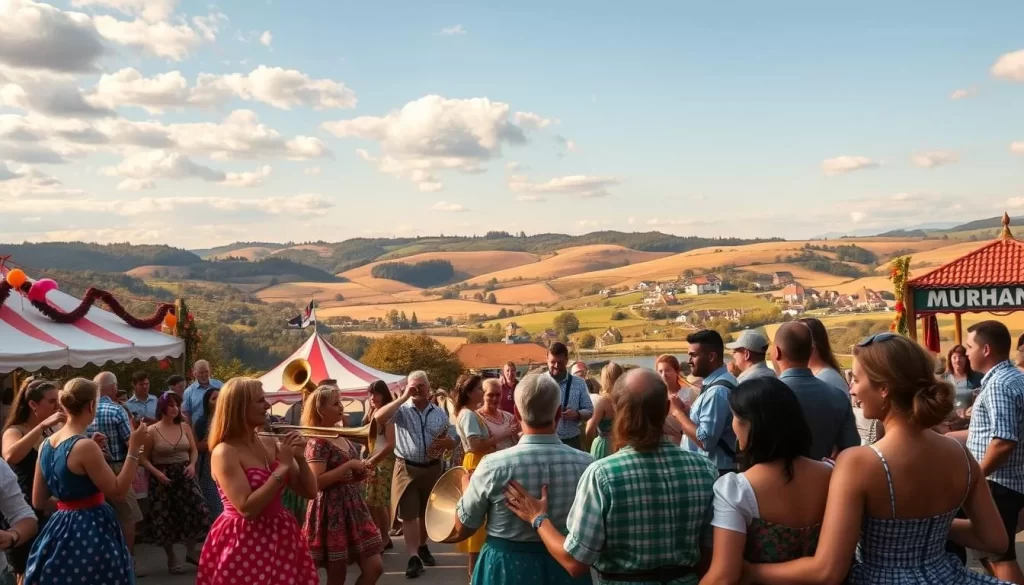
Seasonal Festivals and Local Events
From lively spring fairs to cozy winter markets, Germany’s festivals are a traveler’s delight. Oktoberfest, held in late September, is one of the most famous events in the world. Millions of visitors gather to enjoy traditional food, music, and beer. The warm weather during this time adds to the festive atmosphere.
Christmas markets are another highlight, transforming towns into winter wonderlands. The chilly climate enhances the charm of these markets, where you can sip mulled wine and shop for handmade gifts. These events have a rich history, dating back centuries, and continue to attract international visitors every year.
“Germany’s festivals are a celebration of its culture, history, and seasons.”
Spring brings blooming flowers and outdoor fairs, while summer festivals take advantage of the sunny days. Planning your trip around these events can make your travel experience even more memorable. Here’s a quick look at some must-visit celebrations:
- Oktoberfest: Late September, Munich.
- Christmas Markets: November to December, nationwide.
- Spring Fairs: April to May, various locations.
By aligning your visit with these events, you’ll get a deeper understanding of the local culture. Plus, you’ll enjoy the perfect day out, no matter the season.
Mecklenburg-Vorpommern, Germany: Best Months for a Weather-Savvy Trip
May is the perfect month to explore this region’s natural beauty and vibrant culture. With mild temperatures and sunny days, it’s an ideal time for outdoor activities. The blooming landscapes and fewer crowds make it a traveler’s dream.
Why May is Ideal for Your Visit
May offers a balanced weather experience. Average temperatures range from 55°F to 65°F, making it comfortable for hiking, biking, or strolling through gardens. The rainfall is minimal, ensuring more sunny days for your adventures.
This month also marks the start of the shoulder season. You’ll avoid the summer crowds and enjoy lower accommodation costs. Plus, the region’s landscapes are at their most vibrant, with flowers in full bloom.
Comparing Peak and Shoulder Seasons
Traveling in May means you’ll miss the peak summer rush. During June to August, crowds increase, and prices soar. In contrast, May offers a quieter, more affordable travel experience.
Here’s a quick comparison:
- Weather: May’s mild temperatures are perfect for outdoor activities.
- Crowds: Fewer tourists mean shorter lines and more peaceful days.
- Costs: Accommodation and flights are more affordable compared to summer.
By choosing May for your time visit, you’ll enjoy the best of both worlds—great weather and a relaxed atmosphere. Start planning your trip now to make the most of this magical month.
Spring Delights: Cherry Blossoms and Mild Skies
Spring is a magical time to explore the outdoors, with cherry blossoms painting the landscape in vibrant hues. The weather is mild, making it perfect for long walks and outdoor adventures. Whether you’re strolling through gardens or hiking scenic trails, this season offers endless opportunities to connect with nature.
During this period, the temperature ranges from 50°F to 60°F, creating ideal conditions for extended exploration. The occasional rain shower keeps the air fresh, while sunny days dominate the forecast. This balance ensures that every day is filled with new discoveries.
Outdoor Activities and Nature Walks
Spring brings a variety of outdoor activities to enjoy. Hiking in nature reserves is a popular choice, with trails showcasing the region’s blooming flora. Organized city walks also offer a chance to explore historic sites and vibrant neighborhoods. Here’s a quick guide to making the most of your visit:
- Cherry Blossom Viewing: Visit parks and gardens to witness the stunning bloom of cherry trees.
- Hiking Trails: Explore scenic routes that highlight the color and beauty of spring.
- City Walks: Join guided tours to learn about local history and culture.
Packing essentials include lightweight layers, a waterproof jacket, and comfortable walking shoes. These items ensure you’re prepared for any weather changes during your adventures.
| Activity | Best Time of Day | Recommended Gear |
|---|---|---|
| Cherry Blossom Viewing | Morning | Camera, sunscreen |
| Hiking | Midday | Hiking boots, water bottle |
| City Walks | Afternoon | Comfortable shoes, map |
Spring is a time of renewal and beauty, offering the perfect backdrop for unforgettable experiences. Whether you’re a nature enthusiast or a casual explorer, this season promises something special for everyone.
Summer Charm: Outdoor Festivals and Comfortable Temperatures
Summer brings a lively energy to the region, with festivals and outdoor fun. The weather is warm, averaging 20-25°C, making it perfect for exploring. Long, sunny days invite you to enjoy open-air dining, biergartens, and lakeside relaxation.
This is the time to embrace the vibrant atmosphere. From music festivals to local fairs, there’s always something happening. The comfortable temperature ensures you can enjoy every moment without feeling too hot or cold.
Enjoying Biergartens and Lakeside Relaxation
Summer is synonymous with biergartens. These open-air spots are perfect for sipping a cold beer while soaking in the lively ambiance. Pair your drink with traditional snacks for a complete experience.
For a more serene escape, head to the lake. Whether you’re swimming, kayaking, or simply lounging by the water, it’s a great way to unwind. The warm weather makes these activities even more enjoyable.
Managing Crowds and Costs
Summer is peak travel time, so expect larger crowds and higher costs. To avoid the rush, plan your visit during the early or late parts of the season. This way, you’ll still enjoy great weather without the hassle.
Here are some tips to make the most of your travel:
- Book Early: Secure accommodations and tickets well in advance.
- Explore Lesser-Known Spots: Avoid the busiest areas by discovering hidden gems.
- Plan Your Days: Start early to beat the crowd and make the most of your time.
| Activity | Best Time | Tips |
|---|---|---|
| Biergartens | Evening | Arrive early to secure a spot. |
| Lakeside Relaxation | Midday | Bring sunscreen and water. |
| Festivals | Weekends | Check schedules and plan ahead. |
“Summer is the season of joy, where every day feels like a celebration.”
By following these strategies, you’ll have a memorable and stress-free travel experience. Enjoy the best of summer’s charm while staying prepared for the conditions.
Autumn Splendor: Oktoberfest, Wine Festivals, and Colorful Foliage
Autumn paints the landscape with warm hues, inviting you to explore its charm. The crisp air and golden leaves create a magical atmosphere, perfect for outdoor adventures and cultural celebrations. This season is a favorite for many, offering a mix of vibrant colors, cozy gatherings, and festive events.
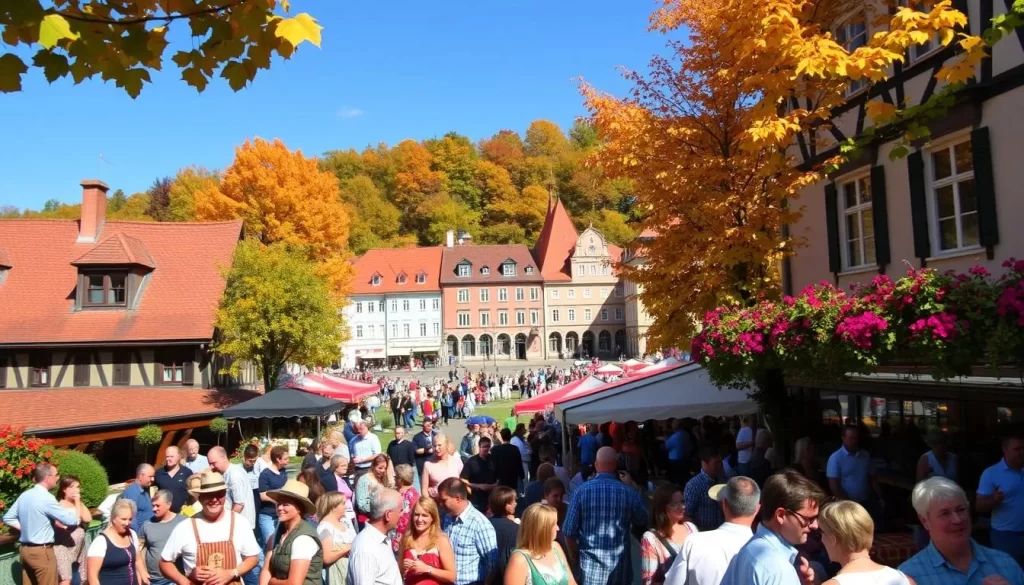
During this time, the temperature ranges from 55°F to 65°F, making it ideal for long walks and outdoor activities. The cooler weather also means fewer crowds, allowing you to enjoy a more intimate visit. Whether you’re sipping wine at a local festival or marveling at the changing leaves, fall promises unforgettable experiences.
Local Harvest Celebrations
Autumn is a time of harvest, and the region comes alive with celebrations. Oktoberfest, held in late September, is one of the most iconic events of the year. Millions of visitors gather to enjoy traditional food, music, and beer. The festive atmosphere is enhanced by the mild weather, making it a must-visit event.
Wine festivals are another highlight, showcasing the region’s rich history of winemaking. These events often feature tastings, live music, and local delicacies. They’re a great way to immerse yourself in the culture while enjoying the crisp autumn air.
“Autumn is a celebration of nature’s bounty and the joy of togetherness.”
Here’s a quick guide to making the most of your visit:
- Oktoberfest: Experience the lively atmosphere and traditional Bavarian culture.
- Wine Festivals: Savor local wines and enjoy live entertainment.
- Foliage Tours: Explore scenic routes to witness the stunning autumn colors.
With shorter daylight hours, it’s important to plan your days wisely. Dress in layers to stay comfortable as the temperature can vary throughout the day. By following these tips, you’ll fully embrace the beauty and joy of autumn.
Winter Magic: Christmas Markets, Snow, and Winter Sports
Winter transforms the region into a wonderland of twinkling lights and snow-covered landscapes. The crisp air and festive atmosphere make it a magical time to visit. Whether you’re sipping mulled wine at a Christmas market or gliding down snowy slopes, this season offers unforgettable experiences.
During this time, temperatures range from -2°F to 4°F, creating ideal conditions for snow activities. The occasional snowfall enhances the charm, turning the region into a picturesque destination. This is the perfect day to embrace the chill and enjoy the cozy warmth of local traditions.
Tips for Staying Warm and Embracing the Chill
To make the most of your winter travel, it’s essential to stay warm. Layer up with thermal clothing and waterproof gear to combat the cold. This ensures you’re comfortable while exploring outdoor attractions or participating in winter sports.
Winter is also an excellent time to avoid crowds. With fewer tourists, you’ll enjoy a more peaceful experience and lower travel costs. This makes it an ideal season for those seeking a quieter getaway.
Here’s a quick guide to winter activities and essentials:
| Activity | Best Time | Recommended Gear |
|---|---|---|
| Christmas Markets | Evening | Thermal layers, gloves |
| Skiing | Midday | Ski jacket, goggles |
| Snowboarding | Morning | Snow boots, helmet |
“Winter is the season of warmth, where every day feels like a celebration of nature’s beauty.”
For more information on planning your winter trip, check out this guide to the most beautiful cities in Germany. It’s packed with tips to help you make the most of your travel experience.
City Weather Focus: Berlin, Munich, and Hamburg Insights
Exploring urban centers like Berlin, Munich, and Hamburg offers a unique blend of culture and climate. Each city has its own weather personality, shaping your travel experience. Whether you’re strolling through Berlin’s parks or enjoying Munich’s festivals, understanding the local weather can make your trip more enjoyable.
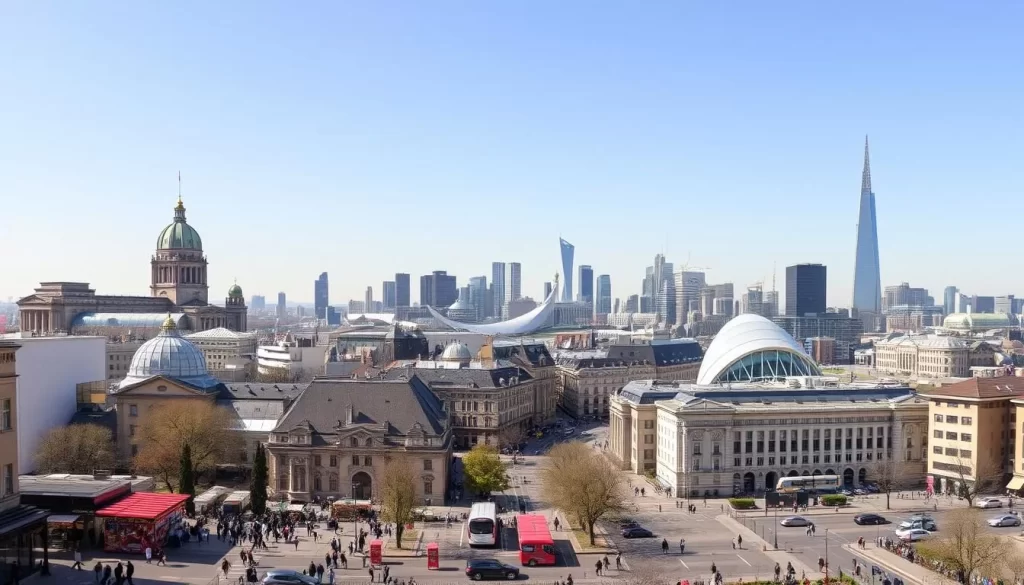
Berlin: Unpredictable Showers and Urban Adventures
Berlin’s weather is known for its unpredictability. One day, you might enjoy sunny skies, and the next, sudden showers. This variability can impact your outdoor plans, so it’s wise to pack layers and a waterproof jacket. The average temperature ranges from -1°C in January to 24°C in July, offering a mix of chilly winters and warm summers.
Rainfall is consistent throughout the year, with July and August being the wettest months. To make the most of your time, check the forecast daily and plan indoor activities as backups. Berlin’s parks and historical sites are still worth exploring, even with occasional rain.
Munich: Stable Weather for Festivals and Fun
Munich’s climate is more stable, making it ideal for outdoor festivals. The city’s famous Oktoberfest thrives in late September, with mild temperatures and clear skies. Summers are warm, averaging 20-25°C, perfect for biergartens and city strolls.
Winters are colder, but the festive atmosphere of Christmas markets keeps the spirit alive. Munich’s reliable weather makes it a great destination for planning ahead. Whether you’re visiting in summer or winter, you’ll find plenty to enjoy.
Hamburg: Maritime Climate and Coastal Breezes
Hamburg’s maritime climate brings cool coastal breezes and moderate temperatures. Summers are pleasant, with averages around 22°C, while winters are milder compared to other cities. The city’s proximity to the sea means occasional rain, but it also adds to its charm.
Outdoor activities like harbor tours and lakeside walks are popular. Hamburg’s weather is perfect for exploring its vibrant neighborhoods and waterfront attractions. Pack a light jacket to stay comfortable during your travel.
Practical Tips for City Exploration
Navigating urban centers requires some preparation. Here’s a quick guide to help you plan your days:
- Check Forecasts: Use reliable information to plan activities and pack accordingly.
- Public Transport: Each city has efficient systems, so get familiar with routes and schedules.
- Indoor Options: Have backup plans for rainy days, like museums or cafes.
| City | Average Temperature (°C) | Rainfall (mm) | Best Time to Visit |
|---|---|---|---|
| Berlin | -1 to 24 | 570 | May-September |
| Munich | -2 to 25 | 900 | June-August |
| Hamburg | 0 to 22 | 750 | May-September |
By understanding each city’s weather patterns, you can make the most of your urban adventures. Whether you’re visiting for a week or a season, these insights will help you plan a memorable trip.
Regional Variations: Differences Between Berlin and Bavaria
Understanding the distinct weather patterns between Berlin and Bavaria can significantly enhance your travel experience. These two regions, though part of the same country, offer vastly different climates that shape your day-to-day activities and overall itinerary.
Berlin: Urban Climate with a Twist
Berlin’s weather is characterized by its urban climate, which can be unpredictable. One day, you might enjoy sunny skies, and the next, sudden showers could disrupt your plans. The average temperature ranges from -1°C in January to 24°C in July, making it a city of contrasts.
Rainfall is consistent throughout the year, with July and August being the wettest months. To navigate this variability, pack layers and a waterproof jacket. Flexibility is key when exploring Berlin’s parks and historical sites, as sudden changes in weather are common.
Bavaria: Continental Charm
Bavaria, on the other hand, boasts a continental climate. Winters are cold and snowy, ideal for winter sports, while springs are mild and perfect for witnessing blooming landscapes. The temperature in Bavaria can drop significantly in winter, often below freezing, but summers are warm and pleasant.
This region’s weather is more predictable, making it easier to plan outdoor activities like hiking or skiing. However, the seasonal shifts are more pronounced, so packing appropriately for the season is essential.
Adjusting Your Itinerary Based on Local Weather
When planning your travel, consider these regional differences. In Berlin, have indoor activities as backups for rainy days. In Bavaria, embrace the seasonal opportunities, whether it’s skiing in winter or enjoying spring blossoms.
Here are some practical tips to help you adjust your plans:
- Pack Smart: Include layers and waterproof gear for Berlin, and thermal clothing for Bavaria’s colder months.
- Stay Flexible: Be prepared to shift activities based on sudden weather changes.
- Plan Ahead: Check forecasts regularly to make the most of your time in each region.
By understanding these regional variations, you can tailor your travel experience to suit your preferences. Whether you’re drawn to Berlin’s urban energy or Bavaria’s natural beauty, being prepared for the weather ensures a memorable trip.
Optimal Times for Tourist and Water Activities
Discover the perfect moments to enjoy outdoor and water-based adventures. Timing your visit ensures you make the most of sunny days and warm temperatures. From swimming to beach outings, planning around the best weather windows guarantees a memorable experience.
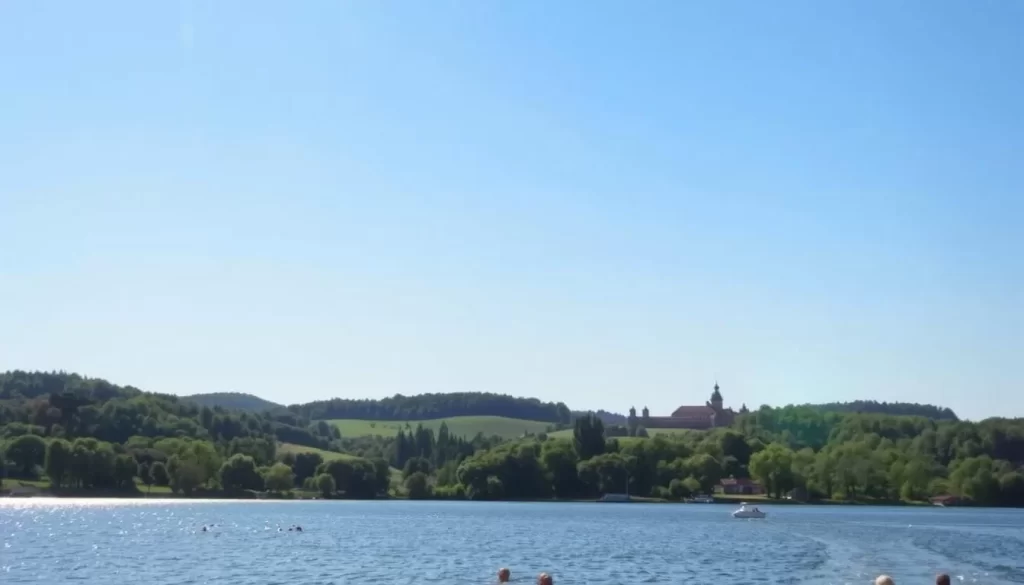
Beach and Pool Scoring for Warm-Weather Fun
The warm season runs from June 2 to September 10, with mid-July to mid-August being the peak for water activities. During this time, the beach and pool score is highest, thanks to ideal temperatures and minimal rain. This score is calculated based on factors like average highs, precipitation, and cloud cover.
Here’s a breakdown of the best times for water-based fun:
- Mid-July to Mid-August: Perfect for swimming, sunbathing, and family outings.
- June and Early July: Great for quieter beach visits and early summer activities.
- Late August to Early September: Ideal for avoiding crowds while still enjoying warm weather.
For those planning family trips, mid-July to mid-August offers the best conditions. Individual water sports enthusiasts might prefer June or September for fewer visitors and more space.
| Month | Average Temperature (°F) | Beach/Pool Score | Recommended Activities |
|---|---|---|---|
| June | 68 – 72 | 7.5 | Swimming, kayaking |
| July | 72 – 75 | 9.0 | Sunbathing, family outings |
| August | 70 – 74 | 8.5 | Water sports, beach parties |
| September | 65 – 70 | 7.0 | Quiet beach visits, hiking |
To secure accommodations during peak travel periods, book early. Popular spots fill up quickly, especially in July and August. Planning your itinerary around these prime days ensures you enjoy every moment of your trip.
“The right timing turns a good trip into an unforgettable adventure.”
By aligning your visit with the best weather conditions, you’ll create lasting memories. Whether you’re a family or a solo traveler, the region offers something for everyone.
Comparing Seasonal Tourism Scores in Mecklenburg-Vorpommern
Understanding the seasonal tourism scores can help you plan your trip more effectively. These scores are calculated based on factors like temperature, cloud cover, and rainfall. By analyzing these elements, you can determine the best time to visit for outdoor and water activities.
Interpreting Temperature, Cloud Cover, and Precipitation Data
The tourism score is a composite index that combines several weather factors. Temperature plays a significant role, as it affects comfort levels for outdoor activities. Cloud cover and rainfall are also crucial, as they determine the number of sunny days and the likelihood of disruptions.
Here’s how the scoring system works:
- Temperature: Scores higher when temperatures are mild and comfortable.
- Cloud Cover: Clear skies boost the score, while overcast conditions lower it.
- Rainfall: Minimal rainfall increases the score, making it ideal for outdoor plans.
For example, July typically has the highest tourism score due to warm temperatures and clear skies. In contrast, November scores lower because of increased cloud cover and rainfall.
| Month | Average Temperature (°F) | Cloud Cover (%) | Rainfall (inches) | Tourism Score |
|---|---|---|---|---|
| July | 72 | 30 | 1.9 | 9.0 |
| November | 44 | 70 | 2.5 | 4.5 |
By using this information, you can choose the best month for your trip. Whether you prefer warm days for swimming or cooler temperatures for hiking, the tourism score helps you make an informed decision.
“The right timing turns a good trip into an unforgettable adventure.”
Remember, while the scores provide valuable insights, your personal preferences also matter. Combining quantitative data with your travel goals ensures a memorable experience.
Practical Travel Tips for an Unforgettable Journey
To make your trip smooth and enjoyable, preparation is key. Whether you’re traveling in summer or winter, knowing what to pack and how to plan can make all the difference. From versatile clothing to local insights, these tips will help you stay ready for any weather or situation.
Packing Essentials for Every Season
Packing smart ensures you’re prepared for any condition. Here’s a breakdown of must-have items for each season:
- Winter: Thermal layers, waterproof boots, gloves, and a warm coat.
- Summer: Lightweight clothing, sunscreen, a wide-brimmed hat, and sunglasses.
- Spring/Fall: Layers, a waterproof jacket, and an umbrella for unpredictable weather.
Don’t forget essentials like a reusable water bottle, a travel adapter, and a first-aid kit. These items are useful no matter the time of year.
Local Insights to Enhance Your Experience
Understanding local customs and schedules can elevate your travel experience. Here are some tips:
- Visit popular sites early in the day to avoid crowds.
- Check local event calendars for festivals or markets during your visit.
- Use public transportation to save time and money.
Staying updated with weather forecasts helps you adjust plans as needed. Apps and local information centers are great resources.
| Season | Essential Items | Local Tips |
|---|---|---|
| Winter | Thermal gear, boots | Visit Christmas markets in the evening. |
| Summer | Sunscreen, hat | Explore beaches early to avoid midday heat. |
| Spring/Fall | Layers, umbrella | Enjoy outdoor festivals and scenic walks. |
By following these tips, you’ll be ready for any adventure. Embrace local customs and unplanned moments to make your travel truly unforgettable.
Conclusion
Every season offers unique experiences, making it a year-round destination for travelers. From mild temperatures in spring to festive winter markets, there’s always something to enjoy. Whether you’re exploring blooming landscapes or attending cultural events, the weather plays a key role in shaping your travel plans.
May stands out as an ideal time to visit, with fewer crowds and pleasant temperatures. However, each season has its charm, from sunny summer days to cozy winter nights. Use the tips and information in this guide to tailor your itinerary and make the most of your visit.
Start planning your adventure today and discover why this destination is a must-see every year. With the right preparation, you’ll create unforgettable memories, no matter the season.
The above is subject to change.
Check back often to TRAVEL.COM for the latest travel tips and deals.
